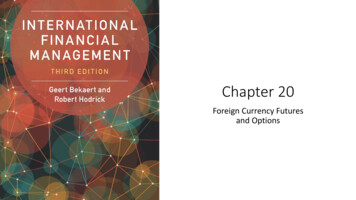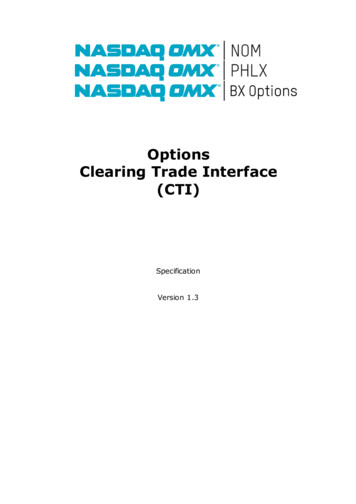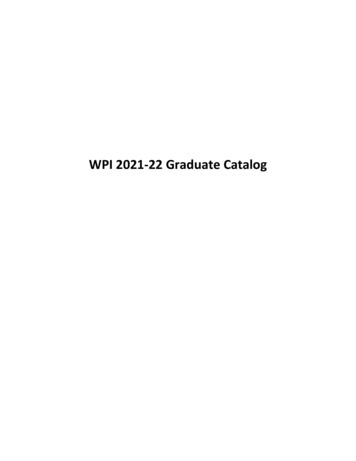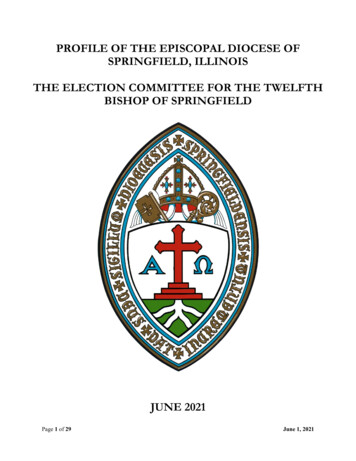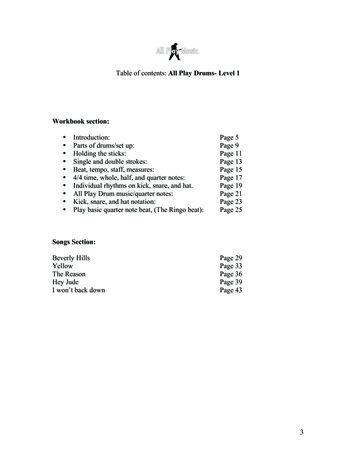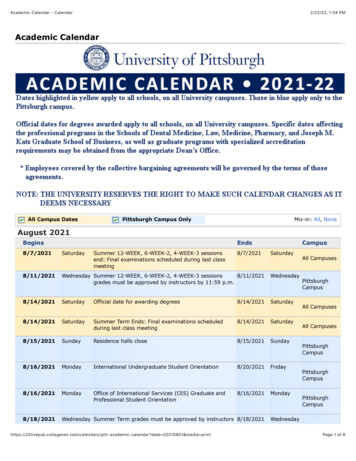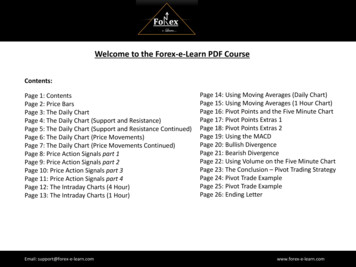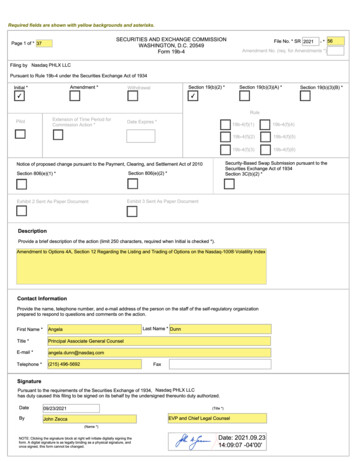
Transcription
SR-Phlx-2021-561.Page 3 of 37Text of the Proposed Rule Change(a)Nasdaq PHLX LLC (“Phlx” or “Exchange”), pursuant to Section 19(b)(1)of the Securities Exchange Act of 1934 (“Act”) 1 and Rule 19b-4 thereunder, 2 is filingwith the Securities and Exchange Commission (“SEC” or “Commission”) a proposal toamend its rule regarding options on the Nasdaq-100 Volatility Index within Options 4A,Section 12, Terms of Index Options Contracts.A notice of the proposed rule change for publication in the Federal Register isattached as Exhibit 1. The text of the proposed rule change is attached as Exhibit 5.2.(b)Not applicable.(c)Not applicable.Procedures of the Self-Regulatory OrganizationThe proposed rule change was approved by the Board of Directors of theExchange on September 23, 2021. No other action is necessary for the filing of the rulechange.Questions and comments on the proposed rule change may be directed to:Angela Saccomandi DunnPrincipal Associate General CounselNasdaq, Inc.215-496-5692115 U.S.C. 78s(b)(1).217 CFR 240.19b-4.
SR-Phlx-2021-563.Page 4 of 37Self-Regulatory Organization’s Statement of the Purpose of, and Statutory Basisfor, the Proposed Rule Changea.PurposeThe Exchange proposes to amend the Nasdaq-100 Volatility Index (“VolatilityIndex”) within Options 4A, Section 12, Terms of Index Options Contracts. Specifically,the Exchange proposes to amend the calculation of the final settlement price for VOLQoptions, the Closing Volume Weighted Average Price or “Closing VWAP,” in the eventany of the thirty-two underlying Nasdaq-100 index (“NDX”) component options do nothave a trade/quote during the 300 second period of time (the “Closing SettlementPeriod”).BackgroundThe final settlement price for the Volatility Index is calculated on Wednesday ofeach week commencing at 9:32:010 A.M. on the expiration day, and continuing eachsecond for the next 300 seconds (New York time). 3 The settlement value for theVolatility Index is the Closing VWAP that is determined by reference to the prices andsizes of executed orders 4 or quotes in the thirty-two underlying NDX component options 53The exercise settlement amount would be equal to the difference between the finalsettlement price and the exercise price of the option, multiplied by 100. Exercisewould result in the delivery of cash on the business day following expiration.4The Exchange proposes to add rule text within Options 4A, Section 12(b)(6)(D)to further describe what is meant by executed orders. Today, the rule text states,“Executed orders shall include simple orders and complex orders however,individual leg executions of a complex order will only be included if the executedprice of the leg is at or within the NBBO.” The proposed change will bedescribed in the proposal section.5Dependent upon movement in the Nasdaq-100 Index, all of the ClosingSettlement Period index (VOLS) thirty-two underlying NDX component optionscan change every second making live market final settlement replicationunfeasible over 300 seconds.
SR-Phlx-2021-56Page 5 of 37on Phlx, Nasdaq ISE, LLC (“ISE”) and Nasdaq GEMX, LLC (“GEMX”) 6 calculated atthe opening of trading on the expiration date (usually a Wednesday). At the end ofindividual one-second time observations during the Closing Settlement Period, whichcommences at 9:32:010 on the expiration day (or 2.00.01 minutes after the open oftrading in the event trading does not commence at 9:30:000 A.M. ET), 7 and continueseach second for the next 300 seconds, the number of contracts resulting from orders 8 andquotes executed on Phlx, ISE and GEMX at each price during the observation period ismultiplied by that price to yield a Reference Number. All Reference Numbers are thensummed, and that sum is then divided by the total number of contracts traded during theobservation period [Sum of (contracts traded at a price x price) total contracts traded)]to calculate a Volume Weighted Average Price for that observation period (a “OneSecond VWAP”) for that component option. If no transactions occur on Phlx, ISE and/orGEMX, during any one-second observation period, the NBBO midpoint at the end of theone second observation period will be considered the One Second VWAP for thatobservation period for purposes of this settlement methodology. Specifically, the ClosingVWAP would seek the best bid and best offer (which may consist of a quote or an order)from among the listing markets (Phlx, ISE and GEMX markets). Each One Second6The Volatility Index’s component NDX options are listed on Phlx as well as onthe Exchange’s affiliates, ISE and GEMX.7If the Exchange is unable to publish a settlement value by 12:00 P.M. (New YorkTime) due to a trading halt, the Exchange will determine and publish a value onits website. In the event of a trading halt, the Exchange will commence thecalculation of the settlement window beginning 2.00.01 minutes after the reopening of trading. See Options 4A, Section 12(b)(6)(D)(II).8Executed orders include simple orders and complex orders, however, individualleg executions of a complex order will only be included if the executed price ofthe leg is at or within the NBBO.
SR-Phlx-2021-56Page 6 of 37VWAP for each component option is then used to calculate the Volatility Index, resultingin the calculation of 300 sequential Volatility Index values. Finally, all 300 VolatilityIndex values are arithmetically averaged (i.e., the sum of 300 Volatility Indexcalculations is divided by 300) and the resulting figure is rounded to the nearest .01 toarrive at the settlement value disseminated under the ticker symbol “VOLS.” 9ProposalThe Exchange proposes to amend the Closing VWAP to provide for an alternativecalculation of the Closing Settlement Period if during any one second of the ClosingSettlement Period any of the thirty-two NDX option series does not have a trade/quote.The alternative observation window would be part of the proposed new calculation of theClosing Settlement Period. The Exchange would add the alternate observation windowto the existing calculation of the Closing VWAP.First, the Exchange proposes if, during any one second of the observation period,any of the thirty-two NDX option series used for Closing VWAP does not have atrade/quote, the index calculator would look back and use the most recent publishedquote 10 midpoint during that day for the One Second VWAP for the option componentthat does not have a trade/quote. If there is no One Second VWAP to utilize for any ofthe thirty-two NDX option series during the Closing Settlement Period, then the indexcalculator will consider that Closing Settlement Period invalid and will be unable todetermine a Closing VWAP at that time.9See Options 4A, Section 12(b)(6)(D)(II), “Terms of Option Contracts.”10Only quotes would be considered, not trades. The Exchange believes that quotesare more reflective of true market value since the index calculator would lookback.
SR-Phlx-2021-56Page 7 of 37Second, in the event the Closing Settlement Period is invalid and a ClosingVWAP cannot be determined, the index calculator will then roll the Closing SettlementPeriod forward by one second and determine if there is a One Second VWAP for each ofthe thirty-two NDX option series for all 300 consecutive seconds of the new ClosingSettlement Period. If there is a One Second VWAP for all of the thirty-two NDX optionseries for all 300 consecutive seconds, a Closing VWAP will be calculated. If a OneSecond VWAP is not present for all of the thirty-two NDX option series during the newobservation period, the index calculator will again roll the Closing Settlement Periodforward by one second. The index calculator would continue to roll the ClosingSettlement Period forward by one second until such time as it is able to capture a OneSecond VWAP for each of the thirty-two NDX option series for all 300 consecutiveseconds. At that time, a Closing VWAP will be calculated.The proposal seeks to create an automated, non-discretionary process by whichthe Exchange would determine the Closing VWAP in the event any of the thirty-twounderlying NDX component options do not have a trade/quote during the ClosingSettlement Period. By creating an automated process, the Closing VWAP would becalculated consistently with the proposed rule. The Exchange does not anticipateutilizing the alternative Closing VWAP calculation on a regular basis. In fact, a reviewof 43 expiration dates 11 from January 2018 through July 2021 revealed invalid values foronly 2 expiration dates. 12 On both of the expiration dates, the Exchange would have11The Exchange reviewed the 9,660 NBBO inputs for the VOLS computation from9:32.01 for the five minute Closing Settlement Period for each expiration date.12The expiration dates were March 18, 2020 and June 17, 2020. The Exchangenotes that the options industry experience unprecedented volumes in 2020.
SR-Phlx-2021-56Page 8 of 37obtained a One Second VWAP for the component by looking forward because the lookback did not contain a quote for the component that was missing a One Second VWAP.In the event of a trading halt in one or more options, excluding a trading halt in allNasdaq-100 index options, prior to the completion of the Closing Settlement Period, theExchange would continue to look back for a One Second VWAP prior to lookingforward. The Exchange believes that it is important to maintain a consistent process forobtaining missing values for the Closing VWAP. As noted above, the Exchange does notbelieve the alternative method would be utilized with any frequency, rather it should beutilized infrequently. In the event a trading halt caused Market Makers to not submit aValid Width Quote in certain components during the Opening Process, 13 the alternativemethodology would look forward to obtain a value. Also, the Exchange would utilize aquote from the Opening Process only in the event an options series was able to open. Ifthe Opening Process did not complete for an options series, there would be no value toobtain for a component during a look back. 14Today, Options 4A, Section 12(b)(6)(D)(II) provides, “If the Exchange is unableto publish a settlement value by 12:00 p.m. (New York time) due to a trading halt, theExchange will commence the calculation of the settlement window beginning 2.00.01minutes after the re-opening of trading and publish that value on its website.” 15 TheExchange proposes to replace this rule text with language which provides, “In the eventof a trading halt in all Nasdaq-100 index options, the Exchange would commence the13The Phlx Opening Process is described within Options 3, Section 8.14The Closing Settlement Period occurs within seconds of the completion of theOpening Process.15See Phlx Options 4A, Section 12(b)(6)(D).
SR-Phlx-2021-56Page 9 of 37calculation of the settlement window beginning 2:00:01 16 minutes after the re-opening oftrading and publish that value on its website. In this scenario, the Exchange would notlook back prior to the trading halt.” The Exchange’s proposal amends the currentsentence to eliminate the 12:00 p.m. timeframe which does not consider all possiblescenarios. A re-opening could occur anytime during the trading day. Further,specifically indicating a trading halt of the Nasdaq-100 index options in the rule text ismore precise as the impact to the Nasdaq-100 index options is a direct concern forVOLQ. The proposed language more directly expands upon the manner in which theClosing VWAP will be handled in the event of a trading halt.While the Exchange believes that the Volatility Index Closing VWAP hasexceedingly high hurdles for potential manipulation, the proposed amendments wouldprovide for a Closing Settlement Period, which has published liquidity for all of thethirty-two NDX option series used for the Closing VWAP. This proposed amendmentwould permit the index calculator to seek a One Second VWAP by first looking back forthe most recent published quote midpoint for that option that had no trade/quote. In theevent the Closing Settlement Period is invalid and a Closing VWAP cannot bedetermined, the index calculator will then continuously roll the Closing Settlement Periodforward by one second until there is a One Second VWAP for all of the thirty-two NDXoption series for all 300 consecutive seconds. This proposed change is designed toensure that all thirty-two NDX components have a One Second VWAP for thecalculation of the Closing VWAP.16The time when the Exchange will commence the calculation of the settlementwindow was corrected from 2.00.001 minutes to 2:00:01 minutes. Thecalculation begins on the second.
SR-Phlx-2021-56Page 10 of 37For example, assume that during the first 59 seconds of the observation period,beginning at 9:32:01 A.M., all thirty-two NDX option components had a One SecondVWAP. During the 60th second, the required NDX component June 18, 2021 14,100 calldoes not have a trade and has a market of 0.00 bid @ 0.00 offer. The index calculatorwould look back to the most recent quote, which occurred at 09:32:57 A.M. and woulduse that quote in the calculation to determine a One Second VWAP for the 60th second(09:33:00 A.M.). However, if during the look back, no quote has occurred since marketopen, the observation period up to and including the 60th second would be consideredinvalid and the new observation period would begin with the next second. In that case,the new observation period would begin at 09:33:01 A.M. and would continue for 300seconds as long as there is a One Second VWAP which can be determined for all 32NDX component options.During the scenario above, if during the 58th, 59th, and 60th second, the requiredNDX component June 18, 2021 14,100 call does not have a trade and has a market of 0.00 bid @ 0.00 offer, then the index calculator would look back to the most recentquote which occurred at 09:32:57 A.M and would use that value in the calculation todetermine the One Second VWAP for the 58th, 59th, and 60th second.The Exchange believes that its proposal would ensure that the Closing VWAP iscalculated using options with sufficient liquidity for each of the thirty-two NDXcomponents by seeking component values that are represented by trades and/or quotes.The Exchange believes that initially looking back for the most recent published quote
SR-Phlx-2021-56Page 11 of 37midpoint for that option will ensure an efficient price for that option component. 17 If theExchange is unable to obtain a One Second VWAP for any of the thirty-two NDX optionseries during the Closing Settlement Period, the Exchange will invalidate the ClosingSettlement Period and move on to calculate the Closing VWAP utilizing a forwardrolling observation period of one second.The Exchange believes rolling the Closing Settlement Period forward by onesecond to obtain a One Second VWAP for each of the thirty-two NDX option series forall 300 consecutive seconds of the new observation period would ensure that the ClosingVWAP is calculated using sufficient liquidity for each of the thirty-two NDXcomponents by seeking trades and/or quotes in a new observation period. Utilizing a onesecond period of time to acquire a new observation window would allow the Exchange toutilize an observation window closest in time to the original window. Also, movingforward in increments of one second, as necessary, would serve to methodically movethrough the trading day for a potential observation window that would satisfy theExchange’s liquidity requirements. This method would continue to assess the entire fieldof NDX options prices each second to select specific listed NDX options to obtain theprices of synthetic precisely at-the-money options. As with the initial Closing SettlementPeriod, since the market is subject to constant change during three hundred individualone-second time periods for which listed options will be included in Closing VWAP,market participants cannot predict which option components will be included becausethat would entail predicting where the NDX price level (a function of predicting the priceof all one-hundred component stocks) will be at the end of each of the three hundred17The Exchange’s calculation is dependent upon values for the 32 componentoptions.
SR-Phlx-2021-56Page 12 of 37individual one-second time periods. In addition, the Exchange notes that the look backperiod would likely not be subject to manipulation as the historical information wouldonly be utilized in the event that liquidity was unavailable in the original observationwindow, which contains options components, which cannot be predicted.The Exchange reiterates that it is unlikely that the Volatility Index ClosingVWAP could be manipulated. In particular, because the thirty-two component VolatilityIndex option inputs 18 are reviewed each second as the market changes to determine theat-the-money strikes (meaning that Volatility Index components could change 300 timesduring the Closing Settlement Period), market participants could manipulate the ClosingVWAP only if they could replicate such value by guessing exact market moves over anextended period of 300 million microseconds. Because the likelihood of replication isextremely low, the Exchange believes that it is unlikely the Closing VWAP could bemanipulated.Nonetheless, the Exchange, in its normal course of surveillance, will monitor forany potential manipulation of the Volatility Index settlement value according to theExchange’s current procedures. Additionally, the Exchange would monitor the integrityof the Volatility Index by analyzing trades, quotations, and orders that affect any of the300 calculated reference prices for any of the NDX option series used for the ClosingVWAP for potential manipulation on the Exchange.Finally, the Exchange proposes to amend the term “executed orders” at Options4A, Section 12, (b)(6)(D)(II) which currently provides, “Executed orders shall include18The Exchange notes that due to the number of proposed components, themathematical formula would prevent the Volatility Index from exceeding 12.5%in any single component and 43.5% for the top 5 components.
SR-Phlx-2021-56Page 13 of 37simple orders and complex orders however, individual leg executions of a complex orderwill only be included if the executed price of the leg is at or within the NBBO.” TheExchange proposes to instead provide, “Executed orders shall include simple orders andcomplex orders (excluding out-of-sequence and late trades), however, individual legexecutions of a complex order will only be included if the executed price of the leg is ator within the NBBO.” The Exchange desires to exclude out-of-sequence and late tradesto avoid potential stale data in the Closing VWAP calculation.ImplementationThe Exchange proposes to issue an Options Trader Alert announcing the day itwill launch options on Nasdaq-100 Volatility Index. The Exchange initially indicatedthat it would launch these options by Q3 2021. 19 At this time, the Exchange proposes tolaunch VOLQ options on or before March 31, 2022.b.Statutory BasisThe Exchange believes that its proposal is consistent with Section 6(b) of theAct, 20 in general, and furthers the objectives of Section 6(b)(5) of the Act, 21 in particular,in that it will permit options trading in the Volatility Index pursuant to rules designed toprevent fraudulent and manipulative acts and practices and promote just and equitableprinciples of trade by amending its Volatility Index to create additional alternative19See Securities Exchange Act Release No. 91781 (May 5, 2021), 86 FR 25918(May 11, 2021) (SR-PHLX-2020-41) (Notice of Filing of Amendment Nos. 1 and2 and Order Granting Accelerated Approval of a Proposed Rule Change, asModified by Amendment Nos. 1 and 2, To List and Trade Options on a Nasdaq100 Volatility Index).2015 U.S.C. 78f(b).2115 U.S.C. 78f(b)(5).
SR-Phlx-2021-56Page 14 of 37observations periods to arrive at a Closing VWAP in the event that any of the thirty-twoNDX option series used for Closing VWAP do not have a One Second VWAP during thefive minute Closing Settlement Period. Phlx’s proposal to amend the Closing VWAP byproposing alternate observations periods would ensure a Closing Settlement Period whichhas published liquidity for all of the thirty-two NDX option series used for ClosingVWAP. The Exchange notes that this alternate methodology may be utilized where thereis no liquidity in any of the thirty-two NDX option series used for Closing VWAP. Thismay be caused by an Exchange system issue, market maker issue, or some news or halt inan underlying.The proposal would promote just and equitable principles of trade by creating anautomated, non-discretionary process by which the Exchange would determine theClosing VWAP in the event any of the thirty-two underlying NDX component options donot have a trade/quote during the Closing Settlement Period. The Closing VWAP wouldbe calculated consistently. The Exchange anticipates the alternative Closing VWAPcalculation would be utilized infrequently. In the event of a trading halt in one or moreoptions, excluding a trading halt in all Nasdaq-100 index options, prior to the completionof the Closing Settlement Period, the Exchange’s proposal to look back for a One SecondVWAP, prior to looking forward, is consistent with the Act because the Exchange’sprocess would be consistent for obtaining missing values for the Closing VWAP. Also,in the event a trading halt caused Market Makers to not submit a Valid Width Quote incertain components during the Opening Process, the alternative methodology would lookforward to obtain a value. Also, the Exchange would utilize a quote from the OpeningProcess only in the event an options series was able to open. If the Opening Process did
SR-Phlx-2021-56Page 15 of 37not complete for an options series, there would be no value to obtain for a componentduring a look back. 22This method would continue to assess the entire field of NDX options prices eachsecond to select specific listed NDX options to obtain the prices of synthetic precisely atthe-money options. As with the initial settlement window, since the market is subject toconstant change during three hundred individual one-second time periods for which listedoptions will be included in Closing VWAP, market participants cannot predict whichoptions components will be included because that would entail predicting where the NDXprice level (a function of predicting the price of all one-hundred component stocks) willbe at the end of each of the three hundred individual one-second time periods. TheExchange reiterates that it is unlikely that the Volatility Index Closing VWAP could bemanipulated. In particular, because the thirty-two component Volatility Index optioninputs are reviewed each second as the market changes to determine the at-the-moneystrikes (meaning that Volatility Index components could change 300 times during thesettlement period), market participants could manipulate the Closing VWAP only if theycould replicate such value by guessing exact market moves over an extended period of300 million microseconds. Because the likelihood of replication is extremely low, theExchange believes that it is unlikely the Closing VWAP could be manipulated.Similarly, with respect to the look back period, it would be unlikely that manipulationcould occur as the historical information would only be utilized in the event that liquiditywas unavailable in the original observation window, which contains options componentswhich cannot be predicted. Nonetheless, the Exchange, in its normal course of22The Closing Settlement Period occurs within seconds of the completion of theOpening Process.
SR-Phlx-2021-56Page 16 of 37surveillance, will monitor for any potential manipulation of the Volatility Index ClosingVWAP and monitor the integrity of the Volatility Index by analyzing trades, quotations,and orders that affect any of the 300 calculated reference prices for any of the NDXoption series used for the Closing VWAP for potential manipulation on the Exchange.Utilizing a time period of one second to acquire a new observation window wouldallow the Exchange to utilize an observation window closest in time to the originalwindow. Also, moving forward in increments of one second, as necessary, would serveto methodically move through the trading day for a potential observation window thatwould satisfy the Exchange’s liquidity requirements.The Exchange’s proposal to amend the term “executed orders” to exclude out-ofsequence and late trades is consistent with the Act as these values may represent potentialstale data in the Closing VWAP calculation. The Exchange believes the midpoint betterreflects the price of a component.Finally, the Exchange’s proposal to amend current Options 4A, Section12(b)(6)(D)(II) to remove the 12:00 p.m. deadline for publishing a settlement value isconsistent with the Act because a re-opening could occur anytime during the trading dayand, therefore, citing specifically to a 12:00 p.m. timeframe does not consider all possiblescenarios. Further, specifically indicating a trading halt of the Nasdaq-100 index optionsin the rule text is more precise as the impact to the Nasdaq-100 index options is a directconcern for VOLQ. The proposed language more directly expands upon the manner inwhich the Closing VWAP will be handled in the event of a trading halt.4.Self-Regulatory Organization’s Statement on Burden on CompetitionThis proposed rule change does not impose any burden on competition that is notnecessary or appropriate in furtherance of the purposes of the Act. The Exchange notes
SR-Phlx-2021-56Page 17 of 37that the proposed alternative observation windows will facilitate the listing and trading ofthe Volatility Index by ensuring liquidity for each of the option components. Theproposed structure will enhance competition among market participants, to the benefit ofinvestors and the marketplace.5.Self-Regulatory Organization’s Statement on Comments on the Proposed RuleChange Received from Members, Participants, or OthersNo written comments were either solicited or received.6.Extension of Time Period for Commission ActionThe Exchange does not consent to an extension of the time period forCommission action.7.Basis for Summary Effectiveness Pursuant to Section 19(b)(3) or for AcceleratedEffectiveness Pursuant to Section 19(b)(2)Not applicable.8.Proposed Rule Change Based on Rules of Another Self-Regulatory Organizationor of the CommissionNot applicable.9.Security-Based Swap Submissions Filed Pursuant to Section 3C of the ActNot Applicable.10.Advance Notices Filed Pursuant to Section 806(e) of the Payment, Clearing andSettlement Supervision ActNot Applicable.11.Exhibits1.Notice of Proposed Rule Change for publication in the Federal Register.5.Text of the proposed rule change.
SR-Phlx-2021-56Page 18 of 37EXHIBIT 1SECURITIES AND EXCHANGE COMMISSION(Release No.; File No. SR-Phlx-2021-56)September , 2021Self-Regulatory Organizations; Nasdaq PHLX LLC; Notice of Filing of Proposed RuleChange to Amend Options 4A, Section 12 Regarding the Listing and Trading of Optionson the Nasdaq-100 Volatility IndexPursuant to Section 19(b)(1) of the Securities Exchange Act of 1934 (“Act”) 1, andRule 19b-4 thereunder, 2 notice is hereby given that on September 23, 2021, NasdaqPHLX LLC (“Phlx” or “Exchange”) filed with the Securities and Exchange Commission(“SEC” or “Commission”) the proposed rule change as described in Items I, II, and III,below, which Items have been prepared by the Exchange. The Commission is publishingthis notice to solicit comments on the proposed rule change from interested persons.I.Self-Regulatory Organization’s Statement of the Terms of Substance of theProposed Rule ChangeThe Exchange proposes to amend its rule regarding options on the Nasdaq-100 Volatility Index within Options 4A, Section 12, Terms of Index Options Contracts.The text of the proposed rule change is available on the Exchange’s Website ules, at the principal office of theExchange, and at the Commission’s Public Reference Room.II.Self-Regulatory Organization’s Statement of the Purpose of, and Statutory Basisfor, the Proposed Rule ChangeIn its filing with the Commission, the Exchange included statements concerningthe purpose of and basis for the proposed rule change and discussed any comments it115 U.S.C. 78s(b)(1).217 CFR 240.19b-4.
SR-Phlx-2021-56Page 19 of 37received on the proposed rule change. The text of these statements may be examined atthe places specified in Item IV below. The Exchange has prepared summaries, set forthin sections A, B, and C below, of the most significant aspects of such statements.A.Self-Regulatory Organization’s Statement of the Purpose of, and StatutoryBasis for, the Proposed Rule Change1.PurposeThe Exchange proposes to amend the Nasdaq-100 Volatility Index (“VolatilityIndex”) within Options 4A, Section 12, Terms of Index Options Contracts. Specifically,the Exchange proposes to amend the calculation of the final settlement price for VOLQoptions, the Closing Volume Weighted Average Price or “Closing VWAP,” in the eventany of the thirty-two underlying Nasdaq-100 index (“NDX”) component options do nothave a trade/quote during the 300 second period of time (the “Closing SettlementPeriod”).BackgroundThe final settlement price for the Volatility Index is calculated on Wednesday ofeach week commencing at 9:32:010 A.M. on the expiration day, and continuing eachsecond for the next 300 seconds (New York time). 3 The settlement value for theVolatility Index is the Closing VWAP that is determined by reference to the prices andsizes of executed orders 4 or quotes in the thirty-two underlying NDX component options 53The exercise settlement amount would be equal to the difference between the finalsettlement price and the exercise price of the option, multiplied by 100. Exercisewould result in the delivery of cash on the bus
minutes after the re-opening of trading and publish that value on its website." 15. The Exchange proposes to replace this rule text with language which provides, "In the event of a trading halt in all Nasdaq-100 index options, the Exchange would commence the . 13 The Phlx Opening Process is described within Options 3, Section 8.




